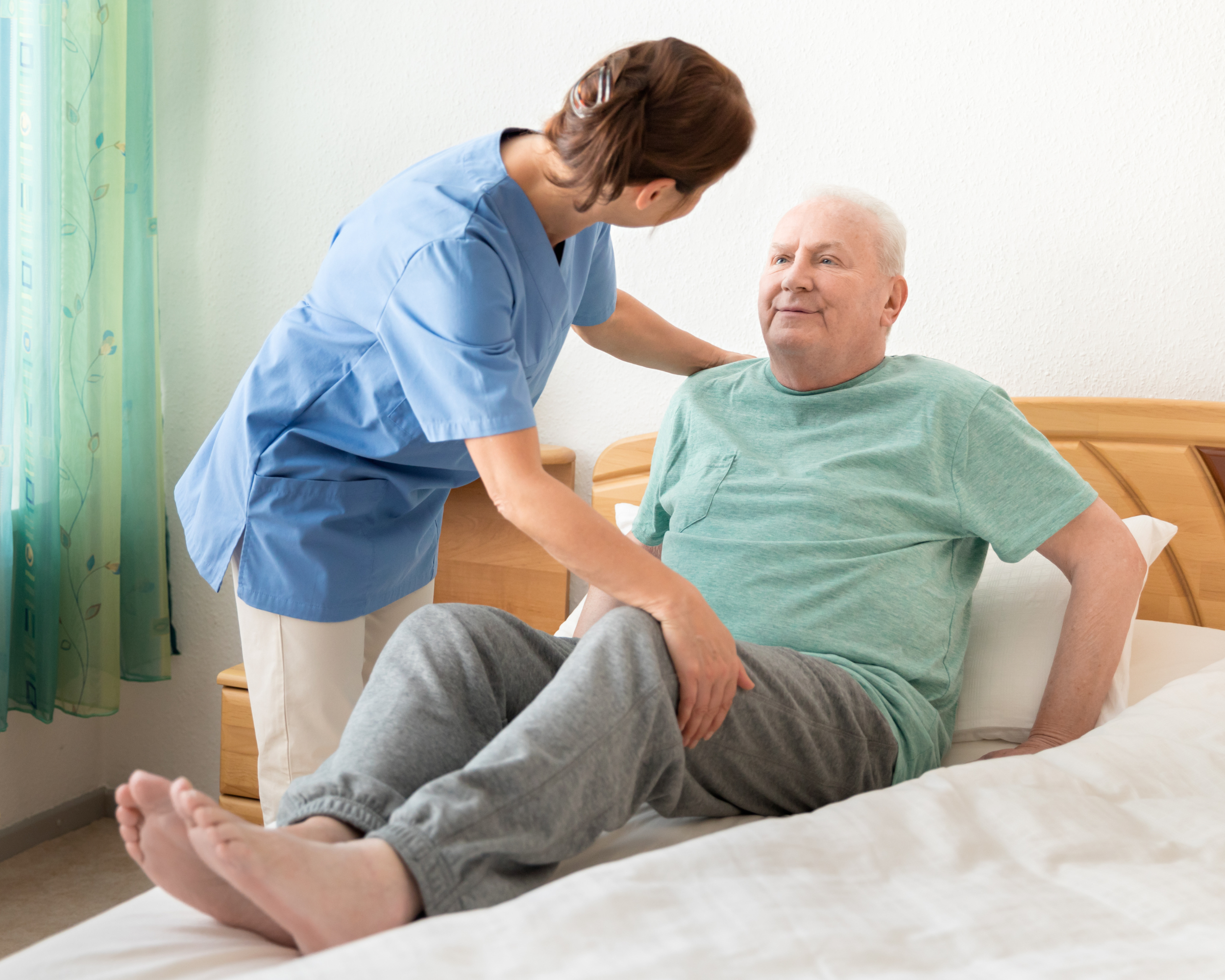Bed alarms and chair alarms for the elderly are essential safety tools designed to prevent falls and wandering. These monitoring devices notify caregivers when a senior at risk of falling attempts to leave a bed or chair. Whether used at home, in assisted living facilities, or in nursing homes, alarms allow caregivers to respond quickly and protect their loved ones.
In this guide, you’ll learn how bed and chair alarms work, the different types available, and how they fit into a complete fall prevention strategy.
The Risks of Falls in Seniors
Falls are one of the leading risks for older adults. In fact, one in four seniors experiences a fall every year. To reduce this risk, families and caregivers must take proactive steps. Bed exit alarms, chair alarms, and wheelchair alarms act as early warning systems, alerting caregivers before accidents happen. These devices significantly improve safety while offering peace of mind to families.
Understanding Elderly Wandering
For seniors with dementia, wandering can be just as dangerous as falling. Bed sensor alarms and chair alarms help caregivers act immediately when a loved one attempts to get up or leave an area unsupervised. Whether at home or in a care facility, these alarms create a safer environment and help prevent serious accidents.
What Is a Bed Alarm?
A bed alarm is a device designed to detect when someone tries to get out of bed, alerting caregivers with an audible sound and flashing light. Some models offer multiple alarm tones to choose from. These patient safety aids are valuable in nursing homes, hospitals, assisted living facilities, and even at home, especially where caregivers cannot be present around the clock to monitor patients at risk of falling.
Types of Bed Alarms
- Pressure Pad Alarms: These bed sensor alarm pads are placed under the bedsheet, beneath the patient’s buttocks or upper back. A caregiver alert is triggered when pressure is removed from the pad as the senior attempts to get out of bed.
- Wireless Bed Alarms: Wireless bed and chair alarms, such as the Secure Wireless Patient Monitoring System and the Secure Caregiver Alert System, utilize wireless technology to send remote alerts to caregivers, even from afar. The alarm monitor can be relocated from the patient room to the nurse station or any other location where the caregiver needs to monitor the patient. The Caregiver Alert System also includes a wireless pager that allows caregivers to be notified from up to 500 feet away from the patient room.
- Motion Sensors: Wireless motion sensors monitor movement around a bed or doorway, making them ideal for individuals prone to wandering.
- Floor Mat Alarms: A floor alarm is an excellent addition to a facility’s fall management strategy. The floor mat is placed beside the bed, and the alarm monitor sounds when a patient steps on the mat while trying to get out of bed. This enhances patient safety by reducing the risk of falls and wandering.
- Chair Alarms for Seniors: Chair alarms and wheelchair alarms, like bed alarms, detect when a person attempts to leave their chair or wheelchair. Both wired and wireless options are available to meet your caregiving needs.
How Do Bed Alarms Work?
Bed alarms for elderly patients function by detecting movement using various technologies such as weight-sensing pressure pads, pull cords, or motion sensors. When a patient attempts to get out of bed, the alarm is triggered, allowing caregivers to respond promptly. Systems like the Secure Wireless Bed Alarm offer remote monitoring, enabling caregivers to receive alerts even when they are away from the patient’s room. Additionally, silent bed alarms are available for environments where loud alarms could be disruptive, ensuring the safety of fall-risk individuals without causing unnecessary disturbances.
Benefits of Using Bed Alarms
Using a bed alarm system for elderly care has multiple benefits:
Fall Prevention – Bed alarms can reduce the risk of falls by providing timely alerts to nurses and caregivers.
Wandering Prevention – Bed sensor alarms for seniors can notify caregivers before an elderly individual wanders off unattended.
Peace of Mind – With devices like bed alarms for seniors at home, caregivers can rest assured knowing they’ll be notified immediately if their loved one tries to get out of bed at any time, day or night.
Choosing the Right Bed Alarm
When selecting a bed exit alarm, consider factors such as:
- Type of Alarm – Decide between pressure sensor pads, pull-cord clip alarms, motion sensors, or floor mats depending on the patient’s needs. Wireless bed alarms provide remote monitoring and reduce alarm noise in patient rooms.
- Power Source – Battery-powered or AC-adapter models.
- Features – Look for alarms that offer customization options, such as silent or wireless alarms, like the Secure Caregiver Alert System. The best bed alarm for the elderly will depend on your specific situation.
Additionally, check the reviews for our top-rated bed alarms for seniors on platforms like Amazon and Walmart.
Are Bed Alarms Covered by Medicare?
A common question is whether Medicare covers bed alarms. Original Medicare (Parts A and B) does not cover bed alarms for fall prevention in the home, as these devices are not classified as durable medical equipment (DME) under Medicare guidelines. However, some Medicare Advantage (Part C) plans may offer coverage for medical alert systems, including bed alarms, depending on the specific plan and provider. It’s advisable to check with your specific Medicare Advantage plan, Medicaid office, or local agencies to determine available coverage or assistance programs for bed alarms.
How to Use Bed Alarms Effectively
Proper Placement
Bed Sensor Pads – Place under the buttocks or upper back, flat and wrinkle-free.
Chair Pads – Position directly on the seat without extra cushions.
Floor Mats – Lay beside the bed or across doorways.
Testing and Maintenance
Regularly check batteries, cables, and volume levels. Confirm the alarm connects properly to monitoring systems.
Training and Response
Caregivers and staff should be trained to:
Respond immediately to all alerts.
Reset or troubleshoot alarms correctly.
Reassess care plans if alarms are triggered frequently.
Additional Considerations
Document the use of alarms in the patient’s care plan and reassess their need regularly.
Alarms should be part of a broader fall prevention strategy that includes risk assessments, mobility aids, and environmental safety checks.
Respect patient dignity and autonomy—use alarms in a way that supports safety without creating a sense of restriction or surveillance.
Best Bed Alarms for Seniors
The best alarm will depend on your caregiving needs. Wireless alarms provide flexibility, while floor mat alarms are ideal for seniors prone to wandering. Reading reviews and comparing features ensures you choose the right system for your situation.
Enhancing Safety with Bed and Chair Alarms
Bed and chair alarms for the elderly are proven tools in fall prevention and safety monitoring. They provide real-time alerts, allowing caregivers to act quickly and reduce the risk of injury. Whether you’re caring for a loved one at home or managing safety in a care facility, these devices offer an added layer of protection and peace of mind.
Investing in the right bed or chair alarm is one of the best steps you can take to keep seniors safe, independent, and supported.

